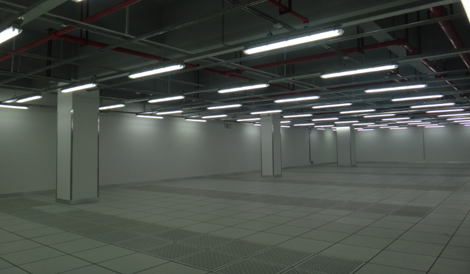GDS’ recently opened its latest data center, in the region of Futian in Shenzhen. With a new blueprint incorporating innovations for efficiency and management, GDS said it heralds a new way of operating for what is one of China’s largest third-party data center operators.
The Futian data center adds to GDS’ cloud nodes in South China, North China, West China and East China and is its 17th facility overall in China, its second in Shenzhen and fifth owned and built by the company itself.
Building the Futian Data Center
The new GDS’s Futian data center has six floors above ground level (a seventh floor is used as a conference space and office). Of these, two to six floors can be used solely for technical equipment. Phase 1 of the facility covers an area of 23,710 sq m and provides 4,925 sq m of whitespace, capable of hosting 2,400 racks.
GDS moved to a modular design method for this new data center, which has access to dual power supplies from two independent substations and dual water supplies through two independent routes. It is configured with N+1 generators and 2N uninterruptible power supplies (UPSs) for redundancy, and offers network connections through various carriers including China Telecom, China Unicom and China Mobile.
Water-cooled chillers are used for cooling, and they are complemented by a reservoir which can provide 72 hours of uninterrupted water supply for the whole data center in case of water outages.
Currently, the new data center is mostly used for the provision of colocation services but GDS plans to provide infrastructure as a service for cloud providers.
William Huang (Huang), the CEO and president of GDS, said half of the space put into use in the Futian Data Center has been rented out, with large internet customers making up a majority of tenants along with financial services and Fortune 500 multinational enterprises.
“It is estimated that Phase 1 will be fully rented by the end of this year,” Huang said. “And GDS is now negotiating with relevant authorities in Shenzhen for its expansion plans.”
GDS has changed its blueprint for this data center design. The building structure in which the main data center is enveloped has enclosed walls that serve as a building shell, with a 2-meter corridor connecting each area. This allows the data center to reduce heat exchange with the outside environment, leading to more constant temperatures. It also adds the level of physical security GDS can offer.
GDS has also used high voltage direct current (HVDC) technology for the first time in its Futian data center.
“The Futian Data Center combines the grid and HVDC for power supply, with each accounting for about 50%. By using HVDC, the data center reduces power conversion times, hence greatly enhancing its energy efficiency,” Huang said.
Data center management tools and systems for standardizing the operation and maintenance works have also been included. Among these is a PAD management system that generates duty schedules, to-do lists and standard operating procedures for all data center tasks.
The PAD system also helps GDS overcome what it says is a constant problem in China’s data center industry – shift changes and inspection delays – by offering real-time input for work carried out.
Geographic advantage
The new data center is located at the Shenzhen Futian Free Trade Zone, between GDS’ Shenzhen Guanlan Data Center and its Hong Kong Kuiyong Data Center. GDS has carefully adhered to guidance from the Chinese financial services industry that end users obtain three data center facilities for redundancy – these should be in two locations, two of which are in the same city.
Its move to be in Shenzhen goes against the grain of recent new builds being seen by large internet companies choosing remote locations over city centers. Amazon, for example, is building in the Ningxia Hui Autonomous Region in Northwest China, near the city of Zhongwei, where a cool climate allows for free cooling.
But Huang says with financial services as a key customer, latency commands the site discussion.
“Shenzhen is located at the national backbone network nodes, which enables GDS to provide low latency network services to its customers,” Huang said.
“It is also where GDS’ important partners including Huawei and ZTE are headquartered; by locating a data center here, the company can have even closer cooperation with those partners.”
Huang said proximity to Hong Kong also enables the data center to play an important role in facilitating information integration between Shenzhen and Hong Kong. It is also conducive to the implementation of the Shenzhen-Hong Kong cooperation model “Shop in Hong Kong and Factory in Shenzhen”, with the former mainly assuming marketing and sales responsibilities, while Shenzhen provides a back-end support base.
Big cloud plans
GDS believes its Futian Data Center will play a big role in the development of the cloud industry in China. Major cloud providers will become tenants, according to Huang.
GDS has been driving the acceleration of cloud across the country in recent years. Three years ago it partnered with Softbank Telecom, building a cloud resource pool in Shanghai. It is also cooperating with Huawei for developing its Industrial Cloud for e-government in Chengdu in West China. And it is working with Alibaba, one of the largest internet players in China, on its Financial Cloud.
“In this new era where cloud is experiencing massive growth, GDS, by taking advantage of its existing infrastructure and service capability, will work hard to lead in the cloud computing arena,” Huang said. “GDS aims to become a ‘Cloud Supermarket’ in the future, attracting international cloud players such as Amazon, Microsoft and IBM.”

